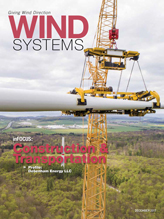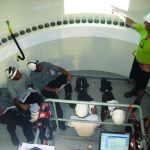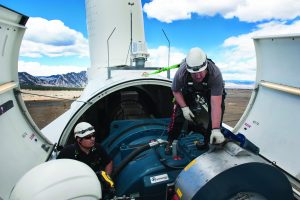If you’re involved in wind power or another endeavor with elevated work, you likely already know that a dropped object prevention program is important. Some might say: “The first step is admitting you have an opportunity.” Once acknowledged, the bigger question is: “How do we get there?”
According to the Bureau of Labor Statistics, 519 people were killed in work-related incidents due to contact with objects or equipment in 2015, and of that figure, 247 were killed when workers were struck by falling objects. Additionally, OSHA reports that, on average, more than 50,000 people a year are “struck by falling objects,” and that’s just the number of reported incidents.
Just how dangerous can a dropped tool be? According to Dropped Object Prevention Scheme (DROPS), an object that weighs less than three pounds dropped from a height of 30 feet can be fatal.
Beyond personal injury and death, there are many other reasons to secure tools.
 A dropped tool can damage equipment, as well as nearby vehicles. And a dropped object can affect productivity. Anyone who has had to do a bonus climb can testify to that. Significant costs — both obvious and hidden — can add up in the absence of an effective drop-prevention program.
A dropped tool can damage equipment, as well as nearby vehicles. And a dropped object can affect productivity. Anyone who has had to do a bonus climb can testify to that. Significant costs — both obvious and hidden — can add up in the absence of an effective drop-prevention program.
As the Labor statistics show, tools and equipment are still being dropped despite the availability of tethering devices. Why is that?
The fact that there are no specific regulations causes confusion, and the result is wide variation across drop prevention programs.
So what’s a reasonable guideline? A simple “Golden Rule” to follow is: When performing elevated work requiring fall protection, tools and other objects should also be secured.
If a worker loses his grip on a hammer while 30 feet in the air, the greatest concern is for personnel and equipment below. Fall protection is about me. Drop prevention is about everyone else.
A poignant example of this happened in 2014 when a one-pound tape measure fell from a worker on a high-rise construction project in New Jersey. As it fell, the object ricocheted off the steel and struck and killed a wallboard delivery person exiting a vehicle. Since the tape did not fall straight to the ground, there’s a question as to whether a hard hat would have provided any protection.

Once this Golden Rule has been embraced, things should be pretty simple, right? Not necessarily. The concept is simple, but getting there isn’t easy. Numerous hurdles often remain.
Shifting culture is always challenging. Asking technicians or craft persons to change the way they work is often the greatest obstacle. This resistance typically comes from the fact that tethering systems tend to inhibit tool use and can significantly reduce productivity. Tools come in many shapes and sizes, so the process of determining how to secure each one is critical.
Purchasing tools and then adding attachment points involves complexity and cost including: procurement logistics, inventory of multiple components, lag time from delivery to deployment, assembly time and associated training, regular inspection of attachment points for degradation, and rework. After all these steps, the final product is frequently rejected by the end-user, and everything described above is before you choose which lanyard is most appropriate for the type of work being done.

The good news is there are best practices for maintaining safety and productivity while working at height. Some of those include:
Engineered attachment points: These help maintain tool functionality and productivity of the tradespeople who use them. They are also drop tested to ensure safety and reliability.
Independent tethering: Most drops happen during the process of transferring tools between hands or onto a lanyard. Minimizing these actions reduces the chance of a drop. This practice also facilitates single hand-tool retrieval, allowing one hand to remain free and maintain “three points of contact” — two feet and one hand always free to secure the worker.
Modularity: Using modules — in which the tool, lanyard, and holster are predetermined, optimized for use together, and preassembled — gives the user flexibility to personalize where the modules are worn while maintaining the integrity of the safety system. Modules are preassembled and eliminate trial and error in the field.
Turnkey systems: Designing and assembling complete drop-prevention systems for specific types of work provides a turnkey, single line item that comes out of the box ready for work.
Standardization: Predetermined modules and turnkey kits help standardize work. Think of the productivity gain if technicians or craft workers could move from one site to the next and have the same tooling in place.
Proper training: Training may be the most important component of a sustainable program. At minimum, a thorough orientation should be considered for all employees and subcontractors. Higher-level train-the-trainer certification curriculum is also available.
An example that brings all facets of this topic together is craftwork during construction. With high-cost and schedule-driven environments, construction projects can’t afford inefficiencies. The fast pace and type of work also lend themselves to dangerous situations. In many cases, drop-prevention programs involve significant resources; however, they ultimately reduce productivity with only incremental safety enhancement. Safety and simplicity are critical. Turnkey solutions, as shown, reduce investment of resources, provide robust safety systems, and deliver out-of-the-box, ready-for-work solutions.




































